Pros and Cons to a Military Camper Lorry
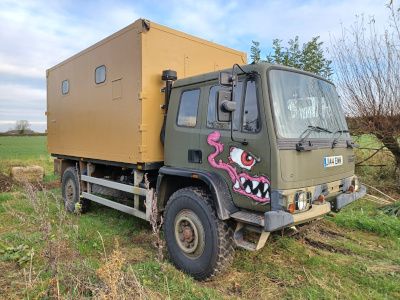
Owning an ex-military lorry converted overland camper isn’t all cool Instagram posts and go-anywhere driving. While there are definitely pros to owning a big-rig camper built from a vehicle which was designed for rough war zones and military defence. There are quite a few drawbacks to it too. I’ve owned my 10.8 tonne ex-military Leyland DAF T244 4x4 since 2016, it’s taken me a while to convert, but I’ve ‘lived’ with it (not in it) for at least a couple of years now. I think it’s only fair to document my true experience. For good measure, I also posed the question of “What’s the Pros and Cons to using this type of truck as a camper?” to a group of similar owners whom I’ve ‘known’ since first purchase.
Comparing this lorry to a standard campervan or motorhome, the ones based on a van chassis like a Transit, VW or similar. Looking at Pros and Cons has come from not always having a great user experience from my own lorry. Sometimes I’ve cursed it, other times it’s been a blessing. But should I have just bought a van in the beginning? Hopefully this will help you make your mind up if you’re on the fence about going van or lorry.
What Is a Military Camper Truck?
I’ve covered what my Military Truck Camper is all about in a previous post, What To Do With A Military Truck. But for fair representation, what I mean by a Military Truck Camper is: it’s a vehicle which has served in the military (of any country) as a General Service (GS) vehicle, has a Gross Vehicle Weight greater than 7.5 tonnes and a Mass of equal or greater than 7.5 tonnes (while converted into a camper). As a General Service vehicle it will have moved people or provisions around, towing trailers or carrying useable bodies (often workshop or communications). Since that life it has been released from the military and taken into private ownership, then converted into an overland camper/motorhome.
What Is a Military Camper Truck Used For?
Used for recreation, a very tough, well built and capable vehicle able to traverse tracks, roads and inclines most campers would struggle with. It’s not hard to see evidence of failure with standard campers or motorhomes, even while they climb moderate inclines in the UK. I’ve seen a few YouTube videos of campers climbing hills in Scotland and the climb resulting in engine/drivetrain failure. That’s not to say there’s something wrong with the basic campervan or motorhome with their white box and thin shell, they simply weren’t designed to be pushed as hard as a military truck.
A military truck camper conversion can generally be accepted to push boundaries of scale further, climbing greater hills, covering rougher ground and taking a few more ‘knocks’ than the standard. They’ll often be taken through rough ground or over uneven territory. They’ll carry larger supplies of water, food and bigger capacity of power, utilising large solar capacities and/or carrying a generator. It’s fair to say they’ll support the user for a longer time off-grid and this is often why they’re used for round-the-world travel.
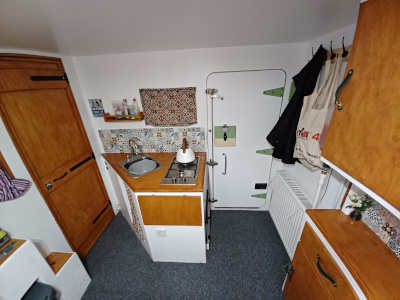
The Cons to Using A Military Truck Camper
Let’s start off with the negatives of using a vehicle of this type, at least that way I can end on a positive.
Fuel, MPG and Costs
Let’s start off with the biggest con, it can even be identified as being the elephant in the room, the fuel consumption or MPG. My Leyland DAF T244 will average around 12 mpg. On some routes it will be worse, when I tow my big trailer it goes down to 9 mpg, but if I’m gentle I can also achieve 14 mpg. But whatever you do, it’s a big use of fuel. The lorry is constant four wheel drive, weighs 8.5 tonnes loaded and is geared to climb, tug and drive through whatever I ask it to. It’s got big knobbly Michelin tyres and so while it’s great at being that obstacle avoiding machine; it’s not great at fuel efficiency.
Put the fuel inefficiency in the real world and what it means is that a week or two away for holidays in the UK can cost me around £500 to £1,000 depending how far we drive. Weekends away have to be localised and even they can cost £200 in fuel. With the price of fuel currently at £1.48 per litre of diesel, it has priced the truck out of general use and reduced it to the bigger trips where it can be used as more accommodation than transport. I often say, it’s expensive to drive but cheap to look at.
The con costs don’t end with fuel; the tyres are huge and are an odd size not commonly found. For that reason they’re also very expensive and it’s common for owners to travel with at least one spare tyre, often even two. A recent tyre law was changed here in the UK for safety and it limited the age of tyres on the steering axle of lorries to a maximum 10 years old. While I support this change, I would have preferred a change to law which concentrated on tyre condition. Many tyres for these vehicles are built incredibly well and with proper maintenance and inner inspections could safely extend the safe use beyond 10 years. The cost of tyres for my truck can start at £350, but to replace my tyres with the same type I currently have could cost £1,200 per tyre or more.
Further costs can be attributed when taking ferries. When my trip to Scotland took us to Orkney the cost of a ferry was by far more expensive than a van would have been. The original charge was almost £450 for a return ticket with a ferry that only took 90 minutes each way. Thankfully, a friend and fellow truck owner helped out with a discount that brought it down to £300.
Slow Speeds
Next, let’s talk speed. As previously mentioned, these trucks are geared low to make them more capable off-road, so it goes without saying that the cruising speed is a little lower. Flat-out my truck will achieve 58mph, though the mpg and engine noise is not good at that speed. I usually cruise around 50/52mph, that’s alright for UK travel or if you’re not in a rush, but crossing countries would take a lot longer.

Parking Problems and Restrictions
Parking is the biggest con for me. If you can accept that it’s not as cheap as a van to pay for, you’ll soon grow bored of struggling to park it. Personally I’ve had mixed experiences with how people have reacted to where or how I’ve parked my lorry, but it’s fair to say that places are just not well equipped for large lorry parking. Not in places where you’ll want to visit anyway. When I visited Scotland I was encouraged by authorities to use empty coach parking or even park on large grass verges when visiting attractions. That can’t be said the same for my trip to Wales, where I narrowly avoided three parking tickets. It’s not that I didn’t pay for parking or pay for the facilities we visited, I did. But because the vehicle didn’t quite fit in a standard car parking bay and clearly was not a coach, we were victimised. It made us negative to the whole experience of travelling to Wales and I don’t think that’s far. But, parking a vehicle which is 2.5 metres wide, almost 7 metres long and 3.5 metres tall is not easy!
Whilst discussing the restrictions of parking and the vehicle dimensions, let’s also discuss the vehicle weight restrictions. Wherever you travel, be it the UK, Europe or wherever, you’ll also likely come across round red circles with a maximum weight restriction for the road. Usually they’re set at a maximum 7.5 tonnes, which most of these vehicles exceed. This restriction is mostly not on the current mass or curb weight, but on the gross vehicle weight by design. There’s also height restrictions, bridges and not forgetting the general shape of some roads having overhanging trees or buildings. As an experienced driver of this type of vehicle and an ex-professional lorry driver I’m accustomed with these roads and how to avoid them. But it does take some planning and can often spoil a good drive by taking you away from where you want to see. In a smaller van you probably wouldn’t even give these restrictions a second thought, but driving this truck it would be constantly on your mind. Making a wrong turn can also be a challenge in something this big. Because a 3 point turn in the road can often be a full-scale mission!
Vehicle Spare Parts
When active in the military, manufacturers would have run-off endless parts to cope with any abuse the soldiers would throw at the trucks. But, once these trucks end their service and effectively become retired, the manufactures also retire their tooling and stop making spare parts. So, unless the part required is a common part for other vehicles, we’re left with whatever is left-over from the military spares cupboard and that cupboard empties quickly! For my truck some body parts have been remanufactured by smaller companies and some spares have been remade using new tooling. But for the majority, you have to learn to adapt and change parts to keep the aging truck moving. This can be costly and in the end your only option may be to use scrap parts from donor vehicles, which are going the same way as my own truck.
Additionally to the availability of spare parts and cost, being a larger vehicle comes with bigger and heavier spare parts. I once took the full exhaust system off my truck so that I could repair-weld the heat shield. Taking that off and putting it back on almost killed me. The same goes for changing a tyre, with the weight of a wheel and tyre together being 160kg, it’s a huge ordeal on my driveway, not to mention if I had to do it at the side of the road. A van would be much more manageable.
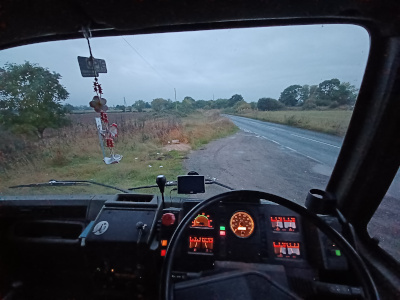
Making The Cab Area Comfortable
These trucks are designed only for military use, not civilian camper conversions. As such, the vehicle cabs are very basic, lacking any sound or heat insulation. The cab area has seating, a central heater and a basic dashboard with controls. Since I’ve owned mine I’ve covered over the engine bulkhead with sound and heat insulation and added specially made cup holders to hold coffee cups. I can plug my phone and sat-nav in using a power point adapted to take USB chargers and I’ve also added a bench seat and two 3-point seat belts to take the kids chairs. But I would still call my cab basic. It would take a lot more work to make it as comfortable as any civilian spec cab.
Climbing Into The Box
The habitation box on a lorry is completely separate to the cab area. Moving from driving and being seated in the cab, to sitting in the box can only be done by exiting the cab and climbing into the box. It’s common for owners to have a ladder or steps stowed away, which are brought out when entering the box. That’s not to say it’s impossible to have a crawl-through between cab and box, but it’s not as straight forward as with a van. With a lorry there is a gap between cab and box by design and this would have to be bridged. A lorry designed for off-road use flexes by chassis, often causing the cab and box to move away or out of align with each other and would clearly create complications with any bridge.
Another point while discussing climbing into the box from the outside; with steps being prominently positioned by the door to the box it’s almost impossible to ignore that someone must be inside. Giving away any chance you would have had of stealth camping. Not that stealth camping is even a possibility with a vehicle like this unless it still looks like a military standard.
Negative Attention
Friends of Greta Thunberg are crying out for electric vehicles, and when you drive a vehicle which not only guzzles fuel but often pipes out diesel smog too, they’re not going to be pleased with you turning up to their town or city. Some people also don’t like the size of the truck, or even what it looks like. Some people are against any large vehicle driving unnecessarily on their roads and slower than they would like to go. Often these people forget that they need lorries to deliver to their shops and take away their rubbish... It’s only fair to say that these vehicles are ‘not everyone’s cup of tea’.
The Pros to Using A Military Truck Camper
Finally, after only 1,600 words describing the negatives, or cons, of a military truck camper, I can now highlight some of the positives. It’s nice to end on a positive.
Ride Height
I wanted to start on my favourite pro, the ride height while seated in the cab. To anybody not familiar with driving a large vehicle, your view of the world around is at a great advantage over lower riding vehicles. You’re able to see above the highest fences and over many of the hedgerows which line UK rural roads, therefore the view you get is mostly unrestricted. You have a clear view of upcoming traffic and them of you, so there’s a safety pro too. Along with safety, you’re also raised away from most other vehicles on the road and in the event of a collision with the majority of other vehicles, you’re probably safer.
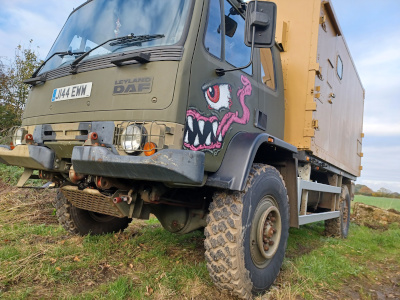
Weight Allowance
My truck has a maximum gross weight of 10.8 tonnes and an empty weight with box of 6.5 tonnes. So effectively when I designed my habitation box I did so with the design to carry lots of fresh water, since I have an allowance of 4.3 tonnes! I can carry in total 500 litres of fresh water plus 90 litres of hot water. I designed a very large space at the rear of my box to carry a generator, tools, and lots of other items needed on a holiday with small kids. I have two fuel tanks, totalling almost 350 litres of diesel, though to counteract the pro I also need bigger tanks to match smaller vehicle’s range.
This weight allowance does allow us to be self-sufficient for longer as the water could last a family of four 2 weeks or more, while showering every day. We hold two very large batteries and they can support our fridge, heating and lighting etc for 4 days without charging. We also carry a petrol battery charger for longer stays, kept in the storage area of the box. Food and clothes are plentiful; again restrictions are few in this area. Some lorry owners also carry a motorbike on their vehicle and have adapted winch powered cranes to raise and lower these bikes to mount to the vehicle.
With the vehicle added height you also have the pro of ground clearance. Ground clearance is not only great for driving over stuff, but if you have maintenance or repairs, that space under your truck is amazing! But ultimately it’s about going places the van wouldn’t be able to and my truck has a wading depth of 1 metre, so water won’t even reach the footwell at that height and I could probably go deeper, especially since I’ve fitted a snorkel.
Habitation Box Size
In basic principles the box of a large vehicle, or lorry, is much greater than that of a van. The box I have is able to support a standard sized double bed, 90cmx80cm shower, large WC, cooking area, large storage, house central heating system and seating for 4 people which also converts into a bunk bed. My setup is so well equipped that I also use my truck as my home-office and regularly spend the full day working from this space. With zoom calls to colleagues, many are not aware I’m even in a vehicle as the layout is similar to any house, with an internal height over 2 metres and it’s testament to why some people choose to live in their truck. All this space in the box and it’s still under 7 metres long.
Quality Vehicle, Well Built and Maintained
The military vehicle engineering budget is clearly greater than that of the average civilian vehicle budget, as the base vehicle is built to a great quality. Nothing military is lightweight and of course everything is able to stand plenty of abuse. That said, these vehicles have rarely been abused and many have rarely been used at all. My truck came with just 2,000km on the clock and this figure was clearly accurate as none of the tyres had much wear from new and all tyres dated to the manufactured date. The exhaust manifold still had original paint towards the edge, showing that it had never had chance to get fully hot, probably of rarely being used. Like any military vehicle mine had many parts which had routinely been replaced, probably not required but the vehicles are kept in top condition... just in case. As a result of the high maintenance procedures, the truck will hopefully outlive many civilian examples.
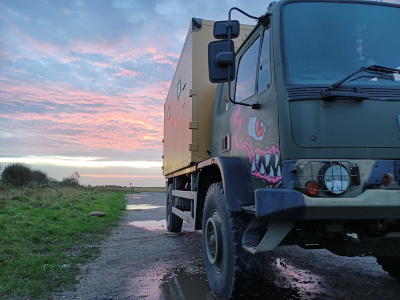
Looks Cool
I said previously that the truck gets some negative attention, but it also gets positive attention. It’s common for people to walk up and start a conversation about the truck and people often speak about how amazing it is and how lucky I am to have it. It’s definitely a head-turner and it often gives me a smile on my face when I return to it. Even cruising on the motorway I get people taking a picture of it as they pass-by. What’s not cool about it?!
Conclusion
Ok, so the cons here do appear to outweigh the pros, and if I’m really honest if I wasn’t so into big lorries and big wheels I probably wouldn’t have bought the truck. If travel is your passion, having a vehicle which enables that travel as efficiently as possible, while you mostly travel tarmac roads, then these trucks are probably not for you. You can be kept quite comfortable in a van, you get plenty of vans with a shower and I’ve even seen vans kitted out to sleep 4 people. So if that’s all you need, don’t buy a great big ex-military lorry and convert it into a camper. Get a van, they sometimes have 4x4 and you could even get a trailer if you need a motorbike too. But, if like me, you get a stiffy grinding gears and the smell of un-burnt diesel fumes fills you with a sense of belonging, then do it...just do it! Certainly don’t keep a record of the fuel you use, that will send you into a deep depression.
